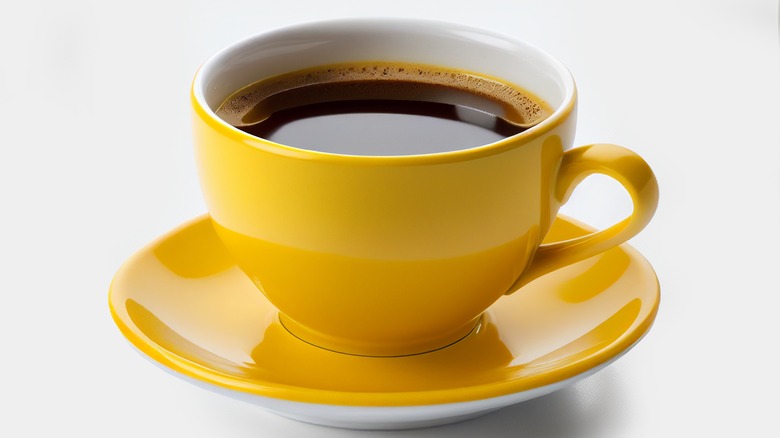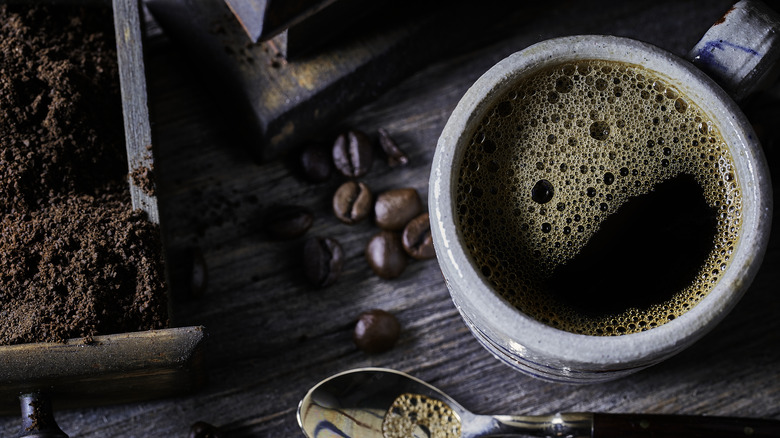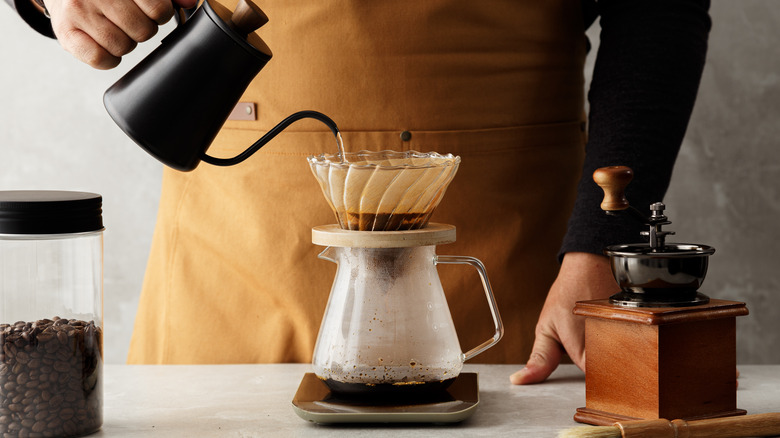How Many Scoops Of Coffee Are Needed For The Perfect Cup?
If you're a coffee fan, you probably already have a recipe for the perfect cup. It might involve some kind of creamer or a specific brewing method, but it's all yours. Everyone can use a little more information, though, and the world of coffee is vast and varied. Before you can get wonky with things like burr grinders and French presses, it's good to know the basics — and with respect to coffee, the first thing to master is the coffee-to-water ratio, which is generally accepted to be 2 tablespoons ground coffee for every 8 ounces of water.
The reason why the coffee-to-water ratio is the most basic step is because it matters irrespective of bean origin, darkness of roast, coarseness of grind, or brewing methodology. It doesn't matter if you're making so-called cowboy coffee by pouring water over coarse grounds in a bowl or are pumped to break out your new glass vacuum siphon contraption: Every cup of coffee starts with coffee and water. But how many scoops are absolutely ideal, and why? Let's look a little more closely at the resulting magic.
The science behind a good cup of joe
If you want to get technical about it, what you're pouring into your favorite mug every morning is a hot combination of chemicals extracted from ground beans of the Ribinacaea coffea plant, enhanced by the aromas and flavors caused by the a roasting process, at concentrations typically between 1.2 and 1.5% by mass. Higher concentrations are possible, but more difficult: A shot of espresso is between 8 and 10% concentration, but you need an expensive machine for that. As you might imagine, an espresso's coffee-to-water ratio is significantly higher, too: 1 part coffee to 2 parts water. Why are these ratios the rule? It has to do with what we call strength, which has to do with the amount of coffee you're using.
When using the humble French press the coffee grounds are immersed in heated water. In the pour-over method, heated water flows through the grounds. Either way, the coffee's various chemicals (tasty volatile compounds, dark melanoidins, phenolic acids, flavonoids, and alkaloids like caffeine) are extracted into the water, which is then filtered and ready to drink. If you use a higher coffee-to-water ratio (like with espresso), you get a stronger, more intense cup — but the brewing process has to be relatively quick. Let the same relative amount of grounds sit in a French press for five minutes and the resulting cup will taste like hyper-caffeinated charcoal water. Like tea, over-extracted coffee is bitter and basically undrinkable.
Under-extraction isn't so hot either
Conversely, an under-extracted cup of coffee is sour and looks like someone dipped a brown Crayon into hot water. This can happen one of two ways: by not letting the grounds steep sufficiently, or by breaking the coffee-to-water ratio and not using enough grounds. Let's get technical: The goal when making the ideal cup of coffee is to extract between 18 and 22% of its 30% soluble compounds. Under-extraction mostly has to do with the steeping process, but we've all had weak coffee — and much of the time that has to do with someone being stingy with the grounds. Even once you've mastered the coffee-to-water ratio, making the stuff by the pour-over method can still take some practice.
Unlike coffee machines or French presses, the flow-through method of making coffee has a few variables. There's an art to making pour-over coffee that goes way beyond observing the coffee-to-water ratio. You'll want to dial in the coarseness of your grind, the temperature of your water, the quality of your filter, and — most crucially — the time you spend during the bloom stage as well as subsequent pours. Is it worth the trouble of learning how to make pour-over right? Without a doubt, but you'll likely be finding that out for yourself soon enough.


